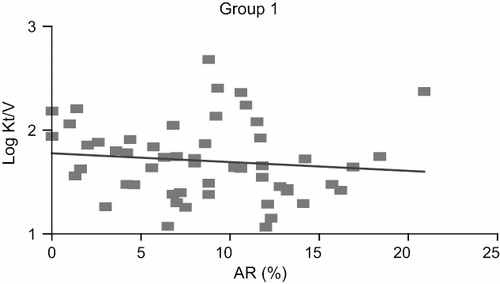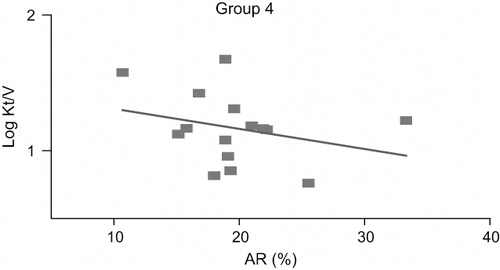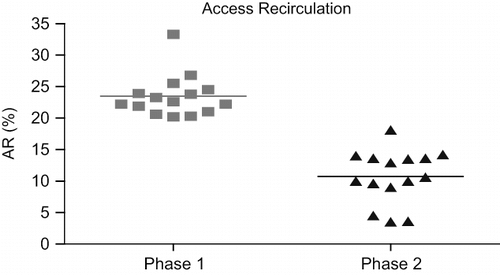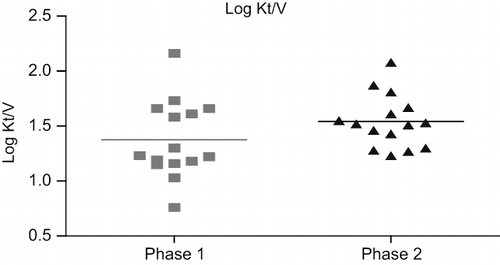Abstract
Objective. To determine the blood recirculation ratio in the vascular access of patients on hemodialysis, and to calculate the Kt/Vs obtained with the different techniques of arteriovenous fistula punctures. Materials and Methods. A total of 174 patients were divided according to the technique used for arteriovenous fistula puncture: group 1, needles in opposite directions and with a distance of 5 cm or more between them; group 2, needles in opposite directions but with a distance of less than 5 cm; group 3, unidirectional needles with both directed to the heart and with a distance of 5 cm or more; group 4, unidirectional needles but separated by a distance of less than 5 cm between needles; and group 5, patients carrying a temporary venous catheter. Blood samples were collected for urea analysis, pre and post-dialysis for Kt/V rate, and other samples for calculation of the access recirculation. Results. Group 1 presented the lowest rate of access recirculation (8.51 ± 4.90%) and the best Kt/V (1.71 ± 0.36), while group 4 presented the worst access recirculation (20.68 ± 4.92%) and Kt/V (1.16 ± 0.26). All groups differed significantly from group 4 (p < 0.05), except group 5 with regard for Kt/V parameter. Discussion. The technique of arteriovenous fistula puncture is an essential factor to decrease the access recirculation and assure better results of measurement of hemodialysis adequacy. On the basis of the results obtained, insertion of the needles in the same direction and with a distance of less than 5 cm between them should be avoided.
INTRODUCTION
Vascular access that will provide adequate blood flow is necessary for patients with chronic renal failure submitted to hemodialysis. The arteriovenous fistula (AVF), created in 1966 by Brescia and Cimino,Citation[1] represented a great advance in the treatment and prognosis of patients on hemodialysis.
Adequate hemodialysis is directly related to a better health condition and to lower morbidity and mortality rates for hemodialysis patients.Citation[2] Kt/V is the concept most extensively used to evaluate the dose of dialysis and its adequacy for patients.Citation[3],Citation[4] However, a good quality of dialysis is provided by a series of factors, among them the technique of AVF puncture and the amount of blood recirculation.
Blood recirculation or access recirculation (AR) occurs when the rate of access flow becomes lower than the rate of dialyzer blood flow,Citation[5] especially in the presence of inadequate location of the needles inserted into the AVF.Citation[6]
The manner in which needles are inserted affects the long-term patency and survival of the access, particularly arteriovenous fistulas.Citation[6] Thus, some care is needed to avoid unnecessary injuries in access and minimize the rate of AR, among these especially the technique of the arteriovenous fistula puncture.
Reis et al.Citation[7] identified the potential relationship between needle placement and the access recirculation rate, particularly when the distance between the needles was less than 5 cm itself.
It is well known that there are other variables besides needle positioning as the cause for high AR that need to be considered before assuming that the needle positioning is the problem. These include low access blood flow, marginal accesses, inflow problem (arterial anastomosis stenosis), venous outlet stenosis, central stenosis, and cardiopulmonary recirculation. However, the technique used to insert needles into the AVF can directly interfere with the rates of blood recirculation, which, when very high, can result in low dialysis doses and higher morbidity and mortality rates. However, adequate puncture depends on the integrity of the vascular access. Thus, the fistula should receive special care for better preservation and a longer useful life. To this end, care is needed on the part of the patient and especially of the nursing team regarding the period that is necessary for fistula maturation and an adequate puncturing technique.Citation[8]
Knowledge of the correct technique of AVF puncture and the etiologic factors that lead to blood recirculation can improve the efficiency of hemodialysis. Inadequate punctures can be visualized by the nurse, who simultaneously diagnoses and corrects them, thus preventing negative effects on hemodialysis adequacy.
The objectives of the present study were to determine by laboratory tests the blood recirculation ratio of the vascular access and calculate the Kt/Vs resulting from the different forms of needle insertion into the AVF and other vascular access, such as a temporary venous catheter, in order to use these parameters for a better adequacy of individually prescribed hemodialysis.
METHODS
The project was approved by the Institutional Review Board, and all participants gave informed consent. It is an observational study and not a randomized one. Patients were included in each group according to the technique of arteriovenous fistula puncture used at the moment of the study. This is the reason for the different numbers of patients among the groups. The procedure of puncture was achieved by a professional of the Service, according to a routine used for all patients.
All patients who presented complications related to a low blood flow of the vascular access, as stenosis or thrombosis, were excluded because these complications may result in high rates of AR and decreasing dialysis efficiency.Citation[6] They were classified as vascular access stenosis, if they were compatible with all the physical findings and showed at least two signals from the clinical evaluation of the data proposed by Besarab and Raja.Citation[9] Data from the physical examination include pulse without vibration; systolic murmur that is discontinuous, rude, and of a high frequency on the place of access; and discontinuous pulse; while data from the clinical evaluation include coagulation repeated twice a month or more; difficult puncture; hemostasis difficulty after the withdrawal of needles (intra-access hypertension); and persistently swollen arm.
The patients who were using temporary double-lumen catheter (DLC) were included in the study only to a comparison effect, as a certain degree of recirculation could be present, and identify whether the use of DLC is better than inadequate puncture of arteriovenous fistula. Data were collected from 174 patients divided into four groups according to the insertion of the needles in the arteriovenous fistula, and another group of patients with DLC. The groups are as follows:
group 1 (N = 53): needle insertion in the classical method, with the arterial set directed at the extremity of the arm and the venous set directed to the heart, with a distance of 5 cm or more between needles;
group 2 (N = 59): needle insertion in the classical method but with a distance of less than 5 cm between them;
group 3 (N = 27): needle insertion in the unidirectional manner, with both needles directed to the heart and with a distance of 5 cm or more between them;
group 4 (N = 15): Needle insertion in the unidirectional manner but with a distance of less than 5 cm between them;
group 5 (N = 20): patients with a DLC.
The inclusion criteria were hemodialysis sessions of four hours duration three times a week, minimum blood flow of 300 mL/min, recommended dialysate flow of 500 mL/min, and giving written informed consent to participate in the study. In addition, the analysis of the patients was standardized for the period between the 7th and 14th reuse of the dialyzers as the clinic uses the automatic method of dialyzer reprocessing (reuse).
A total of five blood samples of 3 to 5 mL each were collected for urea analysis before and after dialysis (for the calculation of Kt/V). For the calculation of AR, three blood samples were simultaneously collected from the arterial (A) and venous (V) set and from the limb contralateral to the vascular access (S). We used this three-site method (blood sample collected from vein of the opposite arm to VA) because it presents better accuracy and reproducibility of urea recirculation.Citation[10] Access recirculation (AR) was calculated in the standard fashionCitation[11]:
For analysis of AR, percentage values were considered to be normal up to 10%.
The blood sample for serum urea determination post-dialysis was collected according to the technique recommended by NKF-DOQICitation[12]: reducing the blood flow of the pump to 50–100 mL/min at the end of dialysis and waiting 20–30 seconds to collect the blood sample in order to prevent sample dilution with recirculated blood and minimize the “urea rebound” effect due to compartmental disequilibrium, thus avoiding a false and underestimated urea value and erroneously elevated Kt/V and urea reduction ratio (URR).Citation[13] (13). Collection was performed with the dialysate turned off, as recommended by NKF-DOQI, and 3 to 5 mL of blood was removed through the arterial set because this is not immediately dialyzed blood.
After laboratory analysis of the samples, the results obtained by automated laboratory methods were applied to the formula mentioned above in order to obtain the percentage of access recirculation for each group. Next, these AR percentages were correlated with their respective Kt/Vs, this being the method used to detect the fractional clearance of urea during hemodialysis (i.e., the hemodialytic dose that was actually administered during treatment [measured Kt/V]). Kt/V was obtained by the Natural Logarithmic Formula (Second Generation or Daugirdas II),Citation[14] and the formula is:
where In is the natural logarithm, R is the ratio of the post- and pre-dialysis urea, t is the duration of hemodialysis (hours), and UF is the ultrafiltration.
This method was chosen because of its simplicity and because it is considered to be the only alternative method to urea kinetics, according to NKF-DOQI.Citation[14]
The access recirculation ratio and logarithmic Kt/V results obtained in the first phase were presented to the medical team and to the office of the clinical director's of the institution. After discussion with these professionals, the team proposed to change the technique of AVF puncture to the technique that presented the lower AR values (group 1). On the basis of the results, the participants who presented AR rates higher than 20% in groups 2–4 had the technique of AV puncture changed. Moreover, the patients of group 5 also were analyzed that in the second phase had mature arteriovenous fistula. Thus, after this modification was carried out by the team, the parameters of AR and hemodialytic adequacy were reanalyzed, representing the second phase of the study. The intent of the last phase was to reinforce the lack of stenosis in the access and thus the importance of using the technique of AV puncture recommended by Besarab et al.Citation[6]
Data are reported as mean and standard deviation for descriptive analysis. For statistical analysis, the program Prism GraphPad version 4 was used. The group data were submitted to one-way ANOVA and the method of Pearson Linear Correlation was used for the analysis of correlation between parameters AR and Kt/V. The level of significance was set at p < 0.05.
RESULTS
Phase 1
Data were collected on 174 patients, including 104 (59.8%) males and 70 (40.2%) females, with a mean age of 51.9 ± 15.57 years. Ethnicity was broken into 103 (59.2%) Caucasian, 50 (28.7%) black, and 21 (12.1%) others (see ).
Table 1 Demographic characteristics according to age, gender, ethnicity, and presence of comorbidities in different groups
A higher mean AR percentage was identified in group 4 (20.68 ± 4.92%) compared to the remaining groups (p < 0.05): group 1 (8.51 ± 4.90%), group 2 (9.64 ± 5.66%), group 3 (10.52 ± 4.64%) and group 5 (13.64 ± 6.63%; see ). In parallel, the same group presented the worst Kt/V values determined by the Daugirdas II formula, with a lower mean value for this parameter (1.16 ± 0.26). All groups except group 5 differed significantly from group 4 (p < 0.05) with regard to Kt/V: group 1 (1.71 ± 0.36), group 2 (1.68 ± 0.30), group 3 (1.68 ± 0.43), and group 5 (1.39 ± 0.37; see ).
Figure 1. Comparison of access recirculation (AR) measurements among the different groups (p < 0.0001). *p < 0.001 (G1 vs. G4, G2 vs. G4, G3 vs. G4); **p < 0.01 (G4 vs. G5).
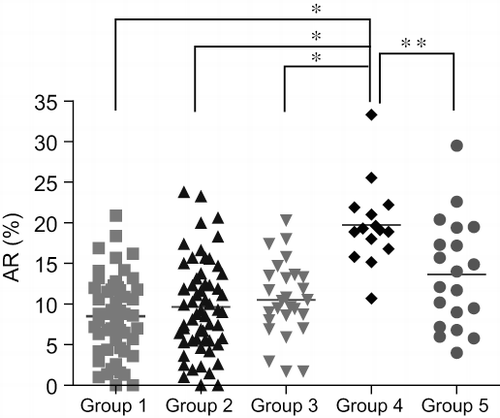
Figure 2. Comparison of mean logarithmic Kt/Vs rates among the different groups (p < 0.0001). *p < 0.001 (G1 vs. G4, G2 vs. G4, G3 vs. G4); **p < 0.01 (G1 vs. G5).
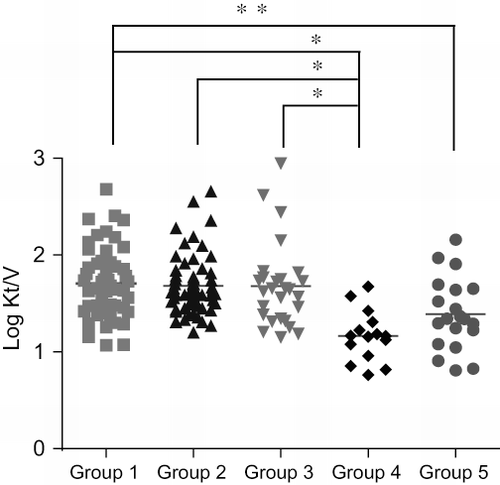
Conversely, the best results for both AR and Kt/V were observed for group 1, as shown in and , respectively. We emphasize that the mean AR values of groups 2, 3, and 5 were not significantly compromised with the maintenance of adequate dialysis doses, as shown in and , respectively.
The results presented in and show that group 4 had the highest mean AR rate and lowest dialysis dose. In addition, it can be seen that group 5 had a higher mean AR value and a lower Kt/V value compared to groups 1, 2, and 3, but lower mean AR rate and better dialysis dose when compared to group 4.
Thus, it can be seen in and , respectively, that all groups differed significantly from group 4 regarding both AR and Kt/V, except for the G4 vs. G5 comparison for Kt/V. Furthermore, the p value was statistically significant in the comparison between groups 1 and 5 regarding the parameters analyzed.
shows that there was no significant correlation between AR and logarithmic Kt/V in group 1. However, a tendency to a decreasing liner curve for this correlation can be seen in for group 4, although the p value was not statistically significant.
Phase 2
In this phase, 15 participants who had presented AR rates higher than 20% in the first phase were studied, 12 of them belonging to the different groups who had AVF as the vascular access (G2 = 4, G3 = 2, G4 = 6) and 3 carrying a temporary venous catheter (that in phase 2 of the study used AVF).
A significant decrease of AR rates was observed in all the cases reanalyzed, most of whom also obtained a higher dose of dialysis, as shown in and . shows a significant decrease (23.47 ± 3.32% vs. 10.71 ± 4.25%, p < 0.0001) of AR rate when the technique of arteriovenous access puncture was modified (phase 2). Although the difference was not significant (1.37 ± 0.35 vs. 1.54 ± 0.24, p > 0.05), an increase in mean dialysis dose received in phase 2 can be seen in .
DISCUSSION
The present data emphasize the fact that the technique of puncture of a definitive vascular access is very important in terms of AR and consequently in terms of hemodialysis adequacy. Group 4 presented the worst results for these parameters compared to group 1. However, groups 2 and 3 maintained AR values close to normal limits, with no impairment of dialytic efficiency.
In a study conducted in order to determine the percentage of AR occurring with the different forms of needle insertion into the AVFs, Reis et al.Citation[7] concluded that the form of needle insertion and the distance between the needles should be considered to be part of the process of recirculation reduction, with the classical form presenting the lowest percentages of AR and with unidirectional needles providing satisfactory results as long as the distance between them is 5 cm or more.
In comparison to this study, we have associated many different forms of needle insertion into the AVFs and their AR rates with the dose of dialysis received. Thus, the correlation between AR and Kt/V in group 4 seems to reveal a tendency to impairment of the dose of dialysis, with higher AR rates.
Puncture of the vascular access should be performed by a trained and qualified professional in order to spare unnecessary injuries to the AVF. Keeping important aspects in needle insertion under observation, it is possible to avoid lesions to vulnerable parts of the vascular access and reduce the probability of recirculation.Citation[9] According to the literature,Citation[6] an adequate technique of vascular access is that in which the arterial needle is kept at a distance of at least 3 cm from the anastomosis, being directed at the extremity of the limb or to the heart, but at a distance of at least 5 cm from the venous needle.
However, in daily practice, it is not always possible to perform this standard puncture due to the presence of complications of the fistula such as stenosis, aneurysm or pseudoaneurysm, or due to the construction of successive fistulas. Thus, in view of these difficulties, it may be necessary to perform punctures with unidirectional needles, both of them in the direction to the heart, or with a distance of less than 5 cm between them. The distance between the needles and their direction, when different from the standard technique, are factors directly related to recirculation, which in turn reduces the efficiency of dialysis.Citation[15]
The impact of AR on the adequate level of dialysis is related to the reduction resulting from the concentration of urea in the blood that flows toward the dialyzer.Citation[16] According to the same authors, when recirculation occurs, the concentration of urea in the blood that enters the dialyzer may be reduced by 5–40% or more in relation to the concentration in distal arterial blood due to mixture with the blood with a low urea concentration that leaves the dialyzer.
The method for calculating in the access recirculation can also be measured by the three-site method (blood sample collected from vein of the opposite arm of the VA) or the two-site method (blood sample obtained from lines arterial and venous). Paulson et al.Citation[10] compared the accuracies of these methods and identified that the reproducibility of the two-site method measurement is poor.
Many peripheral arteriovenous accesses provide an extracorporeal flow rate of 600 mL/min or more. However, in patients with poor vessels or with a partially stenosed access, it may be difficult to obtain an extracorporeal blood flow rate of up to 300 mL/min. Some fistulas function for a long period of time with a low flow, thus compromising the quality of dialysis. As the pump requires more flow than the fistula can provide, considerable recirculation can occur, reducing the expected dose of dialysis.Citation[17]
In patients with a DLC, the mean AR rate was slightly more elevated than in groups 1–3 but lower than in group 4. In parallel, the Kt/V value was lower than that for groups 1–3 but higher than that for group 4. On this basis, all groups, including patients with temporary venous catheter, presented better AR and Kt/V results compared to group 4.
Tonelli and MuirheadCitation[18] investigated the relationship between dialytic adequacy and type of vascular access and concluded that the type of vascular access is not a significant predictor of hemodialysis adequacy, although patients with an AVF or graft tend to receive a greater dose of dialysis than patients with venous catheters.
In the second phase of the present study, when the puncturing technique was modified according to the results of the first phase, there was an extremely significant reduction of AR rate during the different study periods. Although there was no statistically significant difference in the dose of dialysis received in the two phases of the study, the mean Kt/V value increased when the puncturing technique was modified.
On this basis, the nursing team plays a fundamental role in terms of guaranteeing adequate dialysis doses by avoiding the use of inadequate techniques of AVF puncture. To this end, knowledge about the technique of AVF puncture is necessary in order to prevent complications of the vascular access, which, when present, can compromise the blood flow of the access, resulting in high AR rates. The nursing team should use this knowledge when approaching the patients, who in most cases show resistance to move round the site of puncture due to local trauma and pain. It is the responsibility of the nurse to provide health education by informing the patient about the benefits of care of the puncture site, which guarantees greater durability of access and a better quality of dialysis.
Patients with needles inserted in a unidirectional manner and separated by a distance of less than 5 cm (group 4) presented the worst result regarding AR and dialysis adequacy. Conversely, patients with needles inserted in the classical form and separated by a distance of 5 cm or more (group 1) presented the best indices for these parameters.
The results of the second phase of the study, in which the technique of AVF puncture was changed to that used for group 1, confirm the importance of an adequate technique of AVF puncture in order to minimize AR rates and to provide better doses of dialysis to the patients.
DECLARATION OF INTEREST
The authors report no conflicts of interest. The authors alone are responsible for the content and writing of the paper.
ACKNOWLEDGMENTS
Grant supported by Fundação de Apoio ao Ensino, Pesquisa e Assistência do Hospital das Clínicas da Faculdade de Medicina de Ribeirão Preto – USP (FAEPA).
REFERENCES
- Brescia MJ, Cimino JE, Appel K. Chronic hemodialysis using venipuncture and a surgically created arteriovenous fistula. N Engl J Med. 1966; 275: 1089–1092
- Depner TA. Dialysis prescription and adequacy. Clinical Nephrology Dialysis and Transplantation, HH Malluche, BP Sawaya, RM Hakim, MH Sayegh. Dustri-Verlag Dr. Karl Feistle, Rockledge, Fla. 2005; 6: 1–32
- Gotch FA, Sargent JA. A mechanistic analysis of the National Cooperative Dialysis Study. Kidney Int. 1985; 28: 526–534
- Held PJ, Port FK, Wolfe RA, Stannard DC, Carroll CE, Daugirdas JT, Bloembergen WE, Greer JW, Hakim RM. The dose of hemodialysis and patient mortality. Kidney Int. 1996; 50: 550–556
- Cortez AJ, Paulson WD, Schwab SJ. Vascular access as a determinant of adequacy of dialysis. Seminars Nephrol. 2005; 25: 96–101
- Besarab A, Parasurman RPK, Frinak S. Vascular access for hemodialysis. Clinical Nephrology Dialysis and Transplantation, HH Malluche, BP Sawaya, RM Hakim, MH Sayegh. Dustri-Verlag Dr. Karl Feistle, Rockledge, Fla. 2005; 2: 1–34
- Reis EMK, Malvaso GO, Ferraz AEP, Rossi LA. Percentual de recirculação sangüínea, nas diversas formas de inserções das agulhas nas fístulas artério-venosas, dos pacientes em tratamento hemodialítico. Rev Esc Enferm USP. 2001; 35: 41–45
- Raja RM. Acesso vascular para hemodiálise. Manual de Diálise, JT Daugirdas, TS Ing. Medsi, Rio de Janeiro, RJ 1996; 50–72
- Besarab A, Raja RM. Acesso vascular para hemodiálise. Manual de Diálise, JT Daugirdas, PG Blake, TS Ing. Medsi, Rio de Janeiro, RJ 2003; 68–102
- Paulson WD, Gadallah MF, Bieber BJ, Altman SD, Birk CG, Work J. Accuracy and reproducibility of urea recirculation in detecting hemodialysis access stenosis. Nephrol Dial Transplant. 1998; 13: 118–124
- Sherman RA, Levy SS. Rate-related recirculation: The effect of altering blood flow on dialyzer recirculation. Am J Kidney Dis. 1991; 17(2)170–173
- NKF-DOQI. Clinical practice guidelines for measurement of hemodialysis adequacy. Am J Kidney Dis. 2001; 37(l)7–64
- O'Connor AS, Flauto RP, Sehgal AR. Improving the accuracy of Kt/V measurement: The role of the technician. Dial Transplant. 2003; 2(10)590–594
- Daugirdas JT. Second generation logarithm estimates of single-pool variable volume Kt/V: An analysis of error. J Am Soc Nephrol. 1993; 4: 1205–1213
- Santoro A. Confouding factors in assessment of delivered hemodialysis dose. Kidney Int. 2000; 58(76)19–27
- Daugirdas JT, Stone JCV. Princípios fisiológicos e modelo de cinética da uréia. Manual de Diálise, JT Daugirdas, PG Blake, TS Ing. Medsi, Rio de Janeiro, RJ 2003; 15–47
- Daugirdas JT, Kjellstrand CM. Prescrição de hemodiálise crônica: Uma abordagem da cinética da uréia. Manual de Diálise, JT Daugirdas, PG Blake, TS Ing. Medsi, Rio de Janeiro, RJ 2003; 123–150
- Tonelli M, Muirhead N. Access type as a predictor of dialysis adequacy in chronic hemodialysis patients. ASAIO J. 2000; 46(3)279–282
